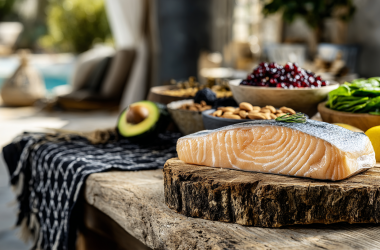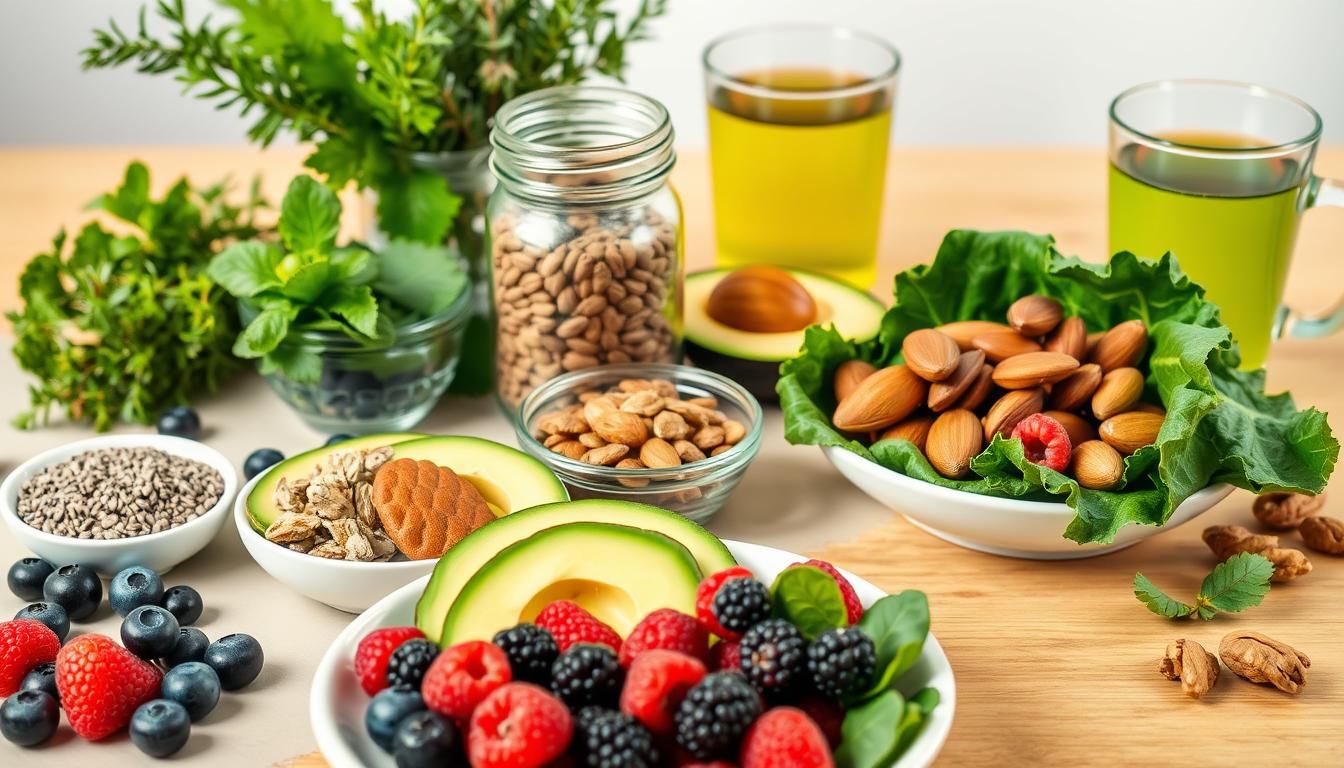The link between our diet and aging is deep and interesting. As a doctor who focuses on nutrition, I’ve seen big changes in patients who eat anti-aging foods. The right foods don’t just make you live longer—they make your life more vibrant.
Our bodies need certain nutrients to age well. While no food can stop time, a good diet can make your skin look better, give you more energy, and boost your overall health. What we eat every day impacts our cells and how we look.
The Mediterranean diet, full of colorful veggies, healthy fats, and lean proteins, is very effective. In my practice, patients who follow this diet often see big improvements quickly. They get brighter skin, better sleep, and more energy.
This guide looks at proven nutrition tips that go beyond just marketing. We’ll look at foods that research says can help slow down aging signs and keep you healthy for the long term.
The Science Behind Nutrition and Aging
The way our diet affects aging is truly fascinating. As a doctor, I’ve seen big differences in aging between people with similar genes but different diets. What we eat helps fix cells and affects our genes over time.
How Food Affects Cellular Aging and DNA Protection
Every meal sends signals to our body, affecting our cells. Foods give us what we need to fix DNA and keep it safe from damage.
Antioxidants in foods like berries and leafy greens help keep our chromosomes healthy. Patients who eat a variety of plants tend to have better cell health than those who don’t.
The Role of Free Radicals, Oxidative Stress and Inflammation
Free radicals are unstable molecules that our body makes. They can be caused by UV rays and pollution. If we can’t get rid of them fast enough, they damage cells and speed up aging.
This damage leads to inflammation, which can make us look older. We see this as wrinkles and sagging skin.
Antioxidants in our food fight off free radicals. This is why eating lots of fruits and veggies helps us age slower.
Why Diet Matters More Than Topical Treatments
Skincare products can’t do as much as a good diet. They only work on the skin’s surface. But food affects every cell in our body.
I tell patients who spend a lot on skincare to focus on their diet. They see better results in their skin and overall health.
The Italians know this well. They believe in eating fresh, nutrient-rich foods for beauty. This inside-out approach is backed by science: real beauty starts with what we eat, not with creams and lotions.
10 Foods That Can Help You Look Younger
Looking younger starts in your kitchen, not in your bathroom. These 10 foods are your secret to youthful skin. They work from the inside out, tackling aging at its source.
The Power of Phytonutrients in Age Prevention
Phytonutrients are plant compounds that give foods their bright colors. They offer amazing anti-aging benefits. These natural chemicals protect your body from aging too fast.
Berries, like blueberries and strawberries, have anthocyanins. These protect skin cells. Eating a cup of mixed berries daily can improve skin clarity in weeks.
Dark chocolate, with 70% cocoa or more, boosts blood flow. This improves skin health. Just one ounce a day can make a big difference.
How These Superfoods Combat Aging at the Cellular Level
Avocados are full of healthy fats. They strengthen cell membranes, keeping moisture in. They also protect DNA from damage.
Turmeric has curcumin, a strong anti-inflammatory. It reduces inflammation that speeds up aging. Add a quarter teaspoon to your meals daily.
Broccoli and other cruciferous veggies detoxify your body. They remove toxins and support DNA repair.
Olive oil has oleocanthal, which fights inflammation like ibuprofen. It reduces chronic inflammation that causes aging.
Daily Consumption Guidelines for Maximum Benefits
For the best results, eat at least five of these foods every day:
- Avocados: ¼ to ½ daily, preferably with breakfast
- Dark chocolate: 1 ounce (about 1 square) daily
- Olive oil: 1-2 tablespoons for cooking or dressing
- Pineapple: ½ cup for its bromelain content
- Flax seeds: 1 tablespoon ground, sprinkled on meals
- Berries: 1 cup daily, fresh or frozen
- Broccoli: 1 cup, lightly steamed to preserve nutrients
- Turmeric: ¼ teaspoon, paired with black pepper for absorption
- Fatty fish: 3-4 ounces, 2-3 times weekly
- Leafy greens: 2 cups daily, varied types
Sticking to these foods for at least six weeks can make a big difference. Patients notice firmer skin and a youthful glow. These foods work best together, not alone.
Mediterranean Diet: The Italian Secret to Longevity
The Mediterranean diet, with its Italian twist, is a top choice for staying young. It’s not just about food; it’s a way of eating that boosts health. This diet offers more benefits than many strict diets because it’s balanced and nourishing.
Why Italians Age So Gracefully: The Blue Zone Connection
Italy is home to “Blue Zones” where people live long and healthy lives. Sardinia, for example, has many centenarians. So, why do Italians age so well?
Their diet is key. It’s full of plants, healthy fats, and a bit of wine. They also stay active and connected, which helps their skin look great.
Key Components of the Traditional Italian Diet
The Italian Mediterranean diet is packed with anti-aging foods:
- Abundant olive oil rich in vitamin E and polyphenols
- Fresh, seasonal vegetables and fruits consumed daily
- Legumes and whole grains as primary carbohydrate sources
- Moderate consumption of fish and seafood
- Limited red meat and processed foods
These foods fight inflammation and support skin health. Olive oil, in particular, keeps skin elastic and smooth.
Scientific Studies Supporting Mediterranean Diet Benefits
The Mediterranean diet’s benefits are backed by science. Studies show it lowers inflammation and oxidative stress, key aging factors.
A big study in the New England Journal of Medicine found it cuts cardiovascular risk by 30%. It also boosts brain health, reducing Alzheimer’s risk by up to 40%.
For skin, the diet’s antioxidants fight UV damage and boost collagen. My patients see better skin and fewer wrinkles in just a few months.
Antioxidant-Rich Fruits for Radiant Skin
Getting vibrant, glowing skin starts with what you eat. Antioxidant-rich fruits are packed with vitamins that fight aging and protect your skin. Eating 2-3 servings of these fruits daily can make your skin look better in just 4-8 weeks.
Berries and Dark Fruits: Nature’s Anti-Aging Gems
Berries are a top choice for fighting aging. Blueberries, blackberries, and strawberries have anthocyanins. These flavonoids are what make these fruits red and blue and give them amazing skin benefits.
Anthocyanins fight free radicals that harm skin cells and speed up aging. They also help control blood sugar, which is key because high blood sugar can cause inflammation and age your skin faster.
Dark cherries and elderberries are also full of antioxidants. They help make blood vessels stronger, improving blood flow and nutrient delivery to your skin.
Citrus Fruits and Vitamin C for Collagen Production
Citrus fruits are essential for glowing skin. Oranges, lemons, grapefruits, and limes are full of vitamin C. Vitamin C is important for making collagen, which keeps your skin firm and young.
As we get older, our collagen levels drop. But vitamin C from citrus fruits helps keep collagen levels up. Patients who eat more vitamin C often see their skin get firmer and lines reduce in 2-3 months.
Citrus fruits also have limonoids that detoxify harmful chemicals. Their acidity helps keep your skin’s pH balanced, which is good for your skin’s health.
Italian Favorites: Grapes, Figs, and Pomegranates
Italian food is full of fruits that fight aging. Red and purple grapes have resveratrol, which helps skin cells stay healthy and protects against UV damage. This might be why Italians in wine areas often look young for their age.
Fresh figs are common in Italy and are full of minerals like magnesium and potassium. They help keep your skin hydrated and support cell function. Their natural sugars and fiber prevent inflammation that can age your skin.
Pomegranates are loved in Mediterranean cultures for their skin benefits. They have ellagic acid and punicalagins that help repair skin and protect against sun damage. Studies show these compounds boost your skin’s ability to heal itself.
Simple Ways to Incorporate These Fruits Daily
It’s easy to add these fruits to your daily routine. Here are some ideas:
- Blend berries into morning smoothies with a splash of citrus juice
- Top yogurt or oatmeal with sliced figs and pomegranate seeds
- Prepare a fruit salad with grapes, berries, and orange segments as an afternoon snack
- Freeze grapes for a refreshing treat that satisfies sweet cravings
- Add lemon or orange zest to your water for all-day skin-nourishing benefits
Being consistent is more important than how much you eat. Even a little bit of these fruits every day can make a big difference in your skin’s health.
Olive Oil and Healthy Fats That Nourish Your Skin
Certain fats are great for keeping your skin young and elastic. Not all fats are good for your skin. The right ones can fight inflammation and keep your skin healthy.
People who eat healthy fats see better skin in just a few weeks. This shows how important food is for your skin’s health.
Extra Virgin Olive Oil: Liquid Gold for Anti-Aging
Extra virgin olive oil is key for fighting aging. It has lots of monounsaturated fats that slow down skin aging. These fats are anti-inflammatory.
It also has antioxidants that protect your skin. Choose cold-pressed, unfiltered olive oil for the best benefits. Look for a harvest date within the past year.
Omega-3 Rich Foods for Skin Elasticity and Hydration
Omega-3s are good for keeping your skin soft and moist. They help your skin stay strong and keep moisture in. They also help with acne and psoriasis.
Great sources of omega-3s include:
- Fatty fish (salmon, sardines, mackerel)
- Flaxseeds and flaxseed oil
- Walnuts and walnut oil
- Chia seeds
- Hemp seeds
Nuts, Seeds, and Avocados for Youth-Preserving Properties
These foods are full of vitamins and minerals that are good for your skin. Vitamin E in them protects your skin from damage. Eating them regularly can make your skin look better.
Almonds, sunflower seeds, and hazelnuts are full of vitamin E. Avocados have vitamin E and healthy fats. Eating a quarter of an avocado a day can make your skin more elastic.
Italian Culinary Applications for These Healthy Fats
Italian food is full of ways to use these healthy fats. Use extra virgin olive oil on veggies or in dressings. Add walnuts to pasta or make pesto with pine nuts and olive oil. These dishes taste great and are good for your skin.
It’s important to choose high-quality foods. Go for organic and minimally processed options. This way, you get the most benefits for your skin.
Protein-Rich Foods That Boost Collagen Production
Protein-rich foods are key to keeping your skin young. They help make collagen, which is vital for your skin’s structure. As we age, our collagen production drops, about 1% each year after 20.
Patients who eat more protein often see their skin get firmer in just a few months. This shows how important it is for your anti-aging diet.
Fish and Seafood for Skin Structure and Repair
Fatty fish like salmon, mackerel, and sardines are packed with protein and omega-3s. These omega-3s fight inflammation and make your skin more elastic and hydrated. They also help protect your skin from UV damage.
Shellfish, like oysters and crab, have zinc and copper. These minerals help strengthen your skin. Eating fatty fish two times a week can boost your collagen levels.
Plant-Based Proteins: Legumes and Their Benefits
Legumes are great for collagen production. Soybeans and products like tempeh and edamame have genistein, which stops collagen breakdown. Chickpeas, lentils, and black beans offer protein and silica, helping make more collagen.
The fiber in legumes also helps control blood sugar. This prevents glycation, which harms collagen. Eating 3-4 servings of legumes a week is recommended for a youthful diet.
Italian Protein Sources: Beans, Lentils, and Lean Meats
Italian food is full of collagen-supporting proteins. Cannellini beans and lentils are rich in protein and copper, which help collagen mature. Italian dishes often feature these beans, along with polyphenols that protect collagen.
Lean meats like rabbit and chicken, cooked simply with olive oil and herbs, provide all the amino acids needed for collagen. The Italian way of using meat in balance with other foods is great for skin health.
Optimal Protein Combinations for Skin Health
Aim for 1.2-1.5g of protein per kilogram of body weight daily. Choose high-quality proteins and vary your sources. Pairing legumes with whole grains or adding a bit of animal protein to plant-based meals is a good idea.
Also, eat foods rich in vitamin C with your protein. Vitamin C is key for collagen production. The Italian way of combining beans with tomato sauce or lemon-dressed fish is a perfect example of a collagen-boosting meal.
Vegetables and Herbs That Fight Aging From Within
Nature’s best anti-aging tools are in colorful veggies and herbs. They are key to diets that help us live longer. These foods have compounds that protect our cells, reduce inflammation, and fight stress.
People who eat a variety of veggies see their skin get better and feel more alive in just a few weeks.
Leafy Greens: The Foundation of Youth and Vitality
Leafy greens are essential for fighting aging. They are packed with vitamins that keep our skin flexible and young. Vitamin K in these greens prevents wrinkles by stopping calcium buildup in elastin fibers.
Spinach, kale, and arugula are full of folate and lutein. These help fix damaged cells and keep our eyes healthy. Radicchio, a favorite in Italy, has anthocyanins that make blood vessels stronger, improving skin health.
- Spinach: Rich in lutein for skin hydration
- Kale: Contains sulforaphane that activates detoxification enzymes
- Arugula: Provides nitrates that improve blood flow to skin cells
- Swiss chard: Delivers magnesium for cellular energy production
Colorful Vegetables and Their Unique Anti-Aging Benefits
Each color of veggie has its own anti-aging benefits. Red tomatoes protect our skin from the sun. Orange carrots and sweet potatoes give us vitamin A, helping our cells grow.
Purple veggies like eggplant boost collagen. Green veggies like broccoli and Brussels sprouts help our body detox and protect cells.
Italian Herbs and Spices with Powerful Antioxidant Properties
Italian herbs are more than just flavor enhancers. They’re full of anti-aging compounds. Rosemary protects our brain cells, while basil fights inflammation.
Oregano is a top antioxidant food, and garlic keeps our heart and skin healthy. These herbs have been key to Italian longevity for ages.
Creating Anti-Aging Vegetable-Based Italian Dishes
Mixing these veggies and herbs creates even more benefits. Italian dishes like minestrone soup and caponata keep veggies’ nutrients while adding flavor.
I tell my patients to eat 5-7 veggies a day, choosing different colors. The “three-color rule” is simple: eat veggies of at least three colors at each meal. This way, you get a wide range of vitamins and antioxidants.
Foods to Avoid: What Accelerates the Aging Process
Knowing which foods speed up aging is key to keeping your skin young. In my work, I’ve seen that cutting out bad foods can make a big difference. Patients often notice less inflammation, fewer fine lines, and brighter skin just one week after changing their diet.
Sugar and Refined Carbohydrates: The Glycation Effect
Sugar molecules attach to proteins in your skin, causing damage. This process, called glycation, harms collagen and elastin. These are the proteins that keep your skin firm and elastic. Foods like white bread, pastries, and sugary drinks are big culprits.
In Connecticut, I’ve seen patients get better skin just by cutting sugar by half. This simple step can do more for your skin than many expensive creams.
Processed Foods and Trans Fats: Skin’s Worst Enemies
Processed foods with trans fats cause inflammation in your body. This inflammation shows up in your skin, making it look older. It breaks down collagen and elastin, and takes away minerals that make your skin look good.
Snacks, margarine, and fried foods are bad for you. Always check the ingredients for “partially hydrogenated oils” to avoid trans fats.
Healthier Italian Alternatives to Common Aging Accelerators
Italian food has great options for avoiding aging foods. Swap processed snacks for a few almonds or walnuts. Choose whole grain pasta like farro instead of white pasta. It’s better for your blood sugar.
For sweet treats, go for fresh fruits instead of desserts. Fruits like figs and cherries are full of antioxidants that help your skin. Patients who make these changes see clearer skin and less inflammation in 2-3 weeks.
Conclusion: Creating Your Personal Anti-Aging Nutrition Plan
Creating an anti-aging nutrition plan is simple. It doesn’t need fancy meal plans or pricey supplements. Just focus on adding the right foods to your daily meals.
Start by slowly adding more foods rich in antioxidants to your diet. Instead of changing everything at once, introduce one new food from our list each week. This way, you avoid feeling overwhelmed and build lasting habits.
In my work, I’ve seen that a simple approach works best. For every meal, aim for:
• 1 quality protein source (like fish, legumes, or lean meats)
• 1 healthy fat (such as olive oil, avocado, or nuts)
• 1-2 colorful vegetables or fruits
This method ensures you get a mix of nutrients that fight aging. Proteins help make collagen, fats nourish skin cells, and plants offer antioxidants.
Remember, it’s the small, daily choices that add up. Your skin regenerates every 27 days. So, give your new diet a month before you see changes.
The Mediterranean diet is a great starting point, but make your plan your own. Choose foods you like and that are easy to find. Your anti-aging journey is personal—nourish it the way that feels right to you.





